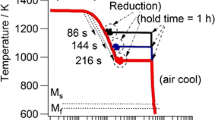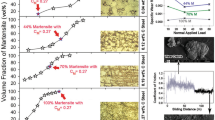Abstract
The tempering behavior was experimentally studied in lath martensitic wear-resistant steels with various Mo/Ni contents after tempering at different temperatures from 200 to 600 C. It is shown that a good combination of hardness (HV) (420–450) and–20 °C impact toughness (38–70 J) can be obtained after quenching and tempering at 200–250 °C. The microstructure at this temperature is lath structure with rod-like and/or flake-like ε-carbide with about 10 nm in width and 100 nm in length in the matrix, and the fracture mechanism is quasi-cleavage fracture combining with ductile fracture. Tempering at temperature from 300 to 400 °C results in the primary quasi-cleavage fracture due to the carbide transformation from resolved retained austenite and impurity segregation between laths or blocks. However, when the tempering temperature is higher than 500 °C, the hardness (HV) is lower than 330 and the fracture mechanism changes to ductile fracture due to the spheroidization and coarsening of cementite. Additions of Mo and Ni have no significant effects on the carbides morphologies at low tempering temperatures, but improve the resistance to softening and embrittling for steels when tempered at above 350 °C.
Similar content being viewed by others
References
JIANG Zhi-qiang, DU Jian-ming, FENG **-lan. Study and Application of Heat Treatment of Multi-Element Wear-Resistant Low-Alloy Steel [J]. Journal of Iron and Steel. Research, International, 2006, 13(1): 57.
Suchanek J, Kuklik V. Influence of Heat and Thermochemical Treatment on Abrasion Resistance of Structural and Tool Steels [J]. Wear, 2009, 267(11): 2100.
WEI Yan, LIN Zhu, WEI Sha, et al. Change of Tensile Behavior of a High-Strength Low-Alloy Steel With Tempering Temperature [J]. Material Science and Engineering, 2009, 517A(1/2): 369.
Lee W S, Su T T. Mechanical Properties and Microstructure Features of AISI 4340 High-Strength Alloy Steel Under Quenched and Tempered Conditions [J]. Mater Proc Tech, 1999, 87: 198.
Horn R M, Richie R O. Mechanisms of Tempered Martensite Embrittlement in Low Alloy Steel [J]. Metall Trans, 1978, 9A: 1039.
Salemi A, Abdollah-Zaden A. The Effect of Tempering Temperature on the Mechanical Properties and Fracture Morphology of a NiCrMoV Steel [J]. Materials Characterization, 2008, 59(4): 484.
Ohmura T, Hara T, Tsuzaki K. Evaluation of Temper Softening Behavior of Fe-C Binary Martensitic Steels by Nanoindenta-tion [J]. Scripta Materialia, 2003, 49(12): 1157.
George Krauss. Martensite in Steel: Strength and Structure [J]. Material Science and Engineering, 1999, 273–275A: 40.
Qin B, Wang Z Y, Sun Q S. Effect of Tempering Temperature on Properties of OOCrl6Ni5 Mo Stainless Steel [J]. Materials Characterization, 2008, 59(8): 1096.
Bevis Hutchinson, Joacim Hagstrom, Oskar Karlsson, et al. Microstructures and Hardness of As-Quenched Martensites (0. 1–0. 5C%) [J]. Acta Materialia, 2011, 59(14): 5845.
Won Jong Nam, Chong Soo Lee, Deok Young Ban. Effects of Alloy Additions and Tempering Temperature on the Sag Resistance of Si-Cr Spring Steels [J]. Material Science and Engineering, 2000, 289A(1/2): 8.
Shiue R K, Lan K C, Chen C. Toughness and Austenite Stability of Modified 9Cr-lMo Welds After Tempering [J]. Material Science and Engineering, 2000, 287A(1): 10.
Maropoulos S, Ridley N, Kechagias J, et al. Fracture Toughness Evaluation of a HSLA Steel [J]. Engineering Fracture Mechanics, 2004, 71(12): 1695.
Andrzej K L. Mechanical Properties and Microstructure of ULCB Steels Affected by Thermomechanical Rolling, Quenching and Tempering [J]. Journal of Materials Processing Technology, 2000, 106(1/2/3): 212.
Author information
Authors and Affiliations
Corresponding author
Additional information
Foundation Item:Item Sponsored by National Basic Research Program (973 Program) of China (2010CB630800)
Rights and permissions
About this article
Cite this article
Cao, Y., Wang, Zd., Kang, J. et al. Effects of Tempering Temperature and Mo/Ni on Microstructures and Properties of Lath Martensitic Wear-Resistant Steels. J. Iron Steel Res. Int. 20, 70–75 (2013). https://doi.org/10.1016/S1006-706X(13)60085-0
Received:
Published:
Issue Date:
DOI: https://doi.org/10.1016/S1006-706X(13)60085-0




